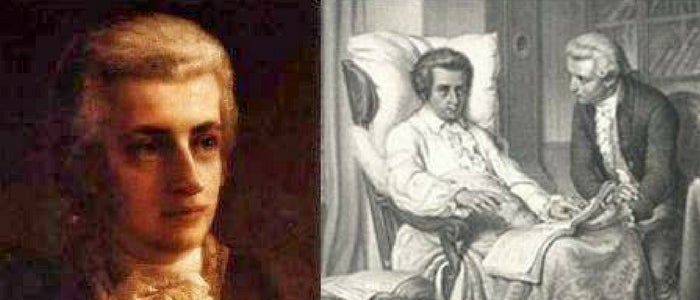Finishing Mozart’s unfinished Requiem

It is hard to believe that so many notes from Mozart’s most beloved choral work are not actually his. When Mozart died, his Requiem was left unfinished. The work fell into the committed hands of his student and disciple, Franz Xaver Süssmayr. He had assisted the sickly Mozart in notating other scores in his final months, and he took on the daunting task of completing the Requiem after his death. The Süssmayr completion is the most accepted version today, and it is the version NJSO and MSU Singers will perform March 15–18.
Over the years, many composers have challenged Süssmayr’s version and have taken a crack at completing Mozart’s original unfinished Requiem or attempted to make what they would consider a more “Mozartean” version.
A big point of contention is the most well-known movement—the chilling “Lacrimosa.” The story goes that Mozart literally died while composing this movement (as immortalized on the big screen by the multiple Academy Award-winning film Amadeus). What is known is that Mozart had only completed eight bars.
First, have a listen to the movement as Süssmayr wrote it:
Now listen to Mozart’s autograph fragment—less than a minute of music. Immediately following is a completion written almost 200 years later by musicologist Ralph Maunder:
Here is a great video of Mozart’s autograph fragment and six completions collected back-to-back, starting with the autograph fragment and the Süssmayr and Maunder versions:
Notice the standard Süssmayr version ends with the familiar “A-men,” while some of the others do not. That is because a sketch of a fugal “Amen” composed by Mozart was discovered after Süssmayr’s completion. A fugue is a subject stated in each voice, sequentially. Composers and musicologists believe that Mozart may have intended this “Amen” fugue to close his “Lacrimosa.” Here is Maunder’s version of Mozart’s “Amen”:
Now here’s a video of Mozart’s fugal “Amen” and five completions written by 20th-century composers and music scholars, including Maunder, who believe this to be more authentic than Süssmayr’s “Amen”:
The opinions on Mozart’s Requiem have evolved to an almost bipartisan belief system. The purists believe in preserving only Mozart’s notes, while others consider Süssmayr’s completion as the only starting point for any edits. However, some scholars and musicians have attempted to compromise between these two schools of thought. British composer Duncan Druce attempted to find middle ground between Süssmayr’s standard completion and Maunder’s cleansed version by honoring Süssmayr’s completion, but also not being afraid to edit it. Druce’s completion has enjoyed wide acceptance and success since its premiere at The Proms in 1991.
Have a listen to Druce’s “Lacrimosa.” Notice its reimagined choral and orchestral parts, altogether new sections, and the substitution of Süssmayr’s “Amen” with the more authentic fugal “Amen.”
Don’t miss the NJSO’s performances of Mozart’s choral masterwork with the Montclair State University Singers and a quartet of vocal soloists March 15–18 at NJPAC in Newark, Richardson Auditorium in Princeton and Mayo Performing Arts Center in Morristown.
RELATED: Watch the Montclair State University Singers’ Road to the Requiem
MOZART’S REQUIEM
2017–18 Season
XIAN ZHANG conductor
Soloists from the CURTIS INSTITUTE OF MUSIC
Emily Pogorelc, soprano | Kendra Broom, mezzo-soprano
Roy Hage, tenor | Doğukan Kuran, baritone
MONTCLAIR STATE UNIVERSITY SINGERS Heather J. Buchanan, conductor
NEW JERSEY SYMPHONY ORCHESTRA
MOZART Ave verum corpus
RHEINBERGER Abendlied for a cappella chorus
PARRY Flame for a cappella chorus
MOZART Requiem
